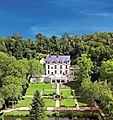Amboise
| Amboise | ||
|---|---|---|

|
|
|
| region | Center-Val de Loire | |
| Department | Indre-et-Loire | |
| Arrondissement | Loches | |
| Canton | Amboise ( chef-lieu ) | |
| Community association | Val d'Amboise | |
| Coordinates | 47 ° 25 ' N , 0 ° 59' E | |
| height | 52-127 m | |
| surface | 40.65 km 2 | |
| Residents | 12,610 (January 1, 2017) | |
| Population density | 310 inhabitants / km 2 | |
| Post Code | 37400 | |
| INSEE code | 37003 | |
| Website | http://www.ville-amboise.fr/ | |
 View of Amboise from the castle |
||
Amboise is a city on the Loire with 12,610 inhabitants (at January 1, 2017) in central France in the Indre-et-Loire in the region of Center-Val de Loire , about 20 km east of Tours . It is the main town ( chef-lieu ) of the canton of the same name .
history
Amboise (after the stream name Ambacia , today Amasse ) was a fortress of the Gauls that was taken over by the Romans. In 503, Clovis I (King of the Franks ) and Alaric II (King of the Goths ) signed a peace agreement here.
The rule of Amboise was given by Charles the Bald Aymon of Buzançais , and by Louis the Stammler to Count Ingelger of Anjou . In the 11th century, Count Fulko Nerra Amboise gave as a dowry to Hersende (see: House Amboise ), the wife of his Seneschal Lisois. Their son Sulpice d'Amboise transferred his feudal oath in 1050 from Anjou to the Count of Blois . At the end of the 11th century it was Angevin vassals who named themselves after Amboise and who ruled alone. In the 12th century, the city was the scene of a brilliant court under Hugues I d'Amboise († 1128), Sulpice's son.
The Amboise reign was confiscated and incorporated into the crown in 1434 because Louis d'Amboise was involved in a conspiracy against Georges de La Trémoille , one of the king's favorites. King Louis XI. , who himself preferred the castle of Plessis-lès-Tours , left Amboise to his family and most of the court. King Charles VIII was born here in 1470, he made Amboise his main residence, and from 1492 he also built the new castle. He died here in an accident on April 7, 1498.
In March 1560 the so-called Conspiracy of Amboise took place in the city during the religious disputes , and in 1563 Catherine de Medici signed the Edict of Amboise , which allowed a restricted exercise of the Protestant faith.
Amboise Castle
The city is dominated by the Amboise Castle from the 15th and 16th centuries. Century. It belongs to the castles of the Loire and was first the residence of the Valois , then a state prison.
Some of the buildings in the palace complex were at the beginning of Italian Renaissance architecture in France. The young King Charles VIII commissioned the building in 1490. After the capture of Naples, the work was continued in 1495 with the involvement of Italian artists. In 1516 Francis I summoned the genius Leonardo da Vinci to his court, who spent his twilight years there from spring 1516 to May 2, 1519.
Leonardo da Vinci lived in the manor house Clos Lucé , located southeast of the castle in a small park. The house was connected to the castle by a 500 meter long underground passage.
In 1627 Amboise was incorporated into the estates of Gaston of Orleans . In 1660 the castle, which was no longer habitable, fell back into the crown domain and served as a state prison; a prominent prisoner was Nicolas Fouquet . In 1762 the Duke of Choiseul acquired the entire complex including the barony and lands, and his heirs sold the property to the Duke of Penthievre in 1786. After the revolution, Amboise was expropriated and large parts of the complex were demolished over the following decades. The rightful heiress, the Duchess of Orléans, could not dispose of the property again until 1815. After her death in 1821, her son, the future King Ludwig Philipp , inherited the castle and all of Amboise's possessions. After his abdication in 1848, the castle was again confiscated and was then the prison for the Algerian freedom fighter Abd el-Kader for four years before it finally fell back to the House of Orléans in 1873.
Attractions
- Amboise Castle from the 15th / 16th centuries century
- Château du Clos Lucé , place of the last work and death of the artist and polymath Leonardo da Vinci
- Château-Gaillard
- Musée de l'Hôtel de Ville (early 16th century); In the former town hall known as the Hôtel Morin you can see a collection with pieces from the history of Amboise.
- Saint-Denis church (12th to 16th centuries)
- Saint-Florentin Church (15th century)
- Porte de l'A Masse , city gate on which a clock tower was built at the end of the 15th century
- Max Ernst Fountain, built 1966–68 on the Loire promenade
- Nearby is the 40 m high pagoda in the center of the park, which formerly belonged to the demolished Chanteloup Castle .
- To the south is the Mini Châteaux amusement park , where 44 of the most important Loire castles can be viewed as models.
Town twinning
Amboise has twinned cities with
|
Personalities
- Charles VIII (1470–1498), King of France
- Francois (1518–1536), Dauphin de Viennois, Duke of Brittany, son of King Francis I and Claude de France
- Charles and Henri Beaubrun (1603–1677 and 1604–1694), painters
literature
- Le Patrimoine des Communes d'Indre-et-Loire. Flohic Editions, Volume 1, Paris 2001, ISBN 2-84234-115-5 , pp. 39-55.










